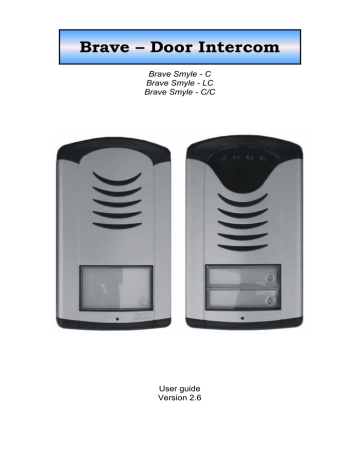advertisement

Relays connection examples are mentiond on following page. It is not all of them but give you an idea how should be connected individual circuits (red rings with numbers = example numbers).
1. Basic connection - 2 elektrical locks and possibility independently control two doors. (relay mode 1 and 2 m=1) or progressive door opening (relay mode 2 m=5 - version (C) only.
2. Two power supply – possibility to use independently two power supply One for Brave Smyle and second for electrical locks. Second electrical lock is connected inversaly (fire emergency exit).
3. Combination of doors with electrical lock and sliding gate at fencing.
4. Extending of previous example (3) about second doors with progressive opening (this feature is setup in TimeRelay - optional modul)
5. Combination of electrical lock and additional ring. Relay of additional ring might be in mode m=4 (from each button is activated for preprogrammed time) or in mode m=6 (it is activated from one presetup button for preprogrammed time)
6. Lighting activation m=3 (for example: way to building ) and control of for example: heating up DAY/NIGHT mode m=8 ( (C) version only - RTC circuit). External power supply required (DIP 3 and 4) /C version only.
Further is neccessary use contactor (Brave Smyle must not activate
230V!).
2.2.1 Code relay (COSW)
For the first switch is available function code relay (COSW CodeSwitch).
It serves primarily to secure transmission of information by switching the electric lock. When using this function is not possible connecting or disconnecting the voltage at the terminals to lock this lock activated. Activation is performed only when positive result compared serial information transmitted between Brave and the board code relay
Brave is set in several codes to activate the relay code.
Relay can be activated codes for one or two impulses can differentiate activated from the phone (DTMF) or from keys
(keyboard). The last option is the activation code in another mode switch than the lock.
The code information is 8 bits, but the code is 4 bits with security 4 bits which is total of 8 bits. Practically, this is performed so that after activation the switch is first transmits the serial code, and if they agree, so code relay connects the electric lock.
The code relays can be connected in parallel to increase the number of switches, but can never combine connections electric lock and the code relay parallel!
16 BRAVE
– user guide
Pict. 2 Examples of relay connection
BRAVE
– user guide
17
2.3 Camera ( /C version only)
Technical parametres:
- videonorm:
- sensor:
- picture area:
PAL-CCIR
CMOS 1/3''
5,78x4,19mm
- resolution:
- video output:
628x582pixel 380 rows
1V p-p/75 ohm
- automatic profit control: 18dB
- minimal lighting: 3LUX
- automatic lens shutter: 1/60-1/15000sekund
- camera view: 50st.
18
- zoom: manually
BRAVE
– user guide
2.4 Accssesories
2.4.1 Weather hood
It increases intercom protection during raining. It is fixed by adhesive labels from sides.
2.4.2 TimeRelay
Time relay allows expansion of relays functionality. It is individual product and detail manual you find on our websites www.alphatech.cz
2.4.3 DistyBox
This optional modul is plastic box allows you to connect analog unit (phone, intercom) into wireless system DECT –
GAP (for example Siemens line GigaSet,
TopCom line Butler etc.). DistyBox is suitable for intercom connection when are cables not available. You just registrate intercom as handset to DECT base station. All features of intercom are kept.
Important: DECT base station must support
DTMF transmission between each handsets
(relay activation feature).
BRAVE
– user guide
19
advertisement
* Your assessment is very important for improving the workof artificial intelligence, which forms the content of this project
Related manuals
advertisement
Table of contents
- 6 BASIC DESCRIPTION
- 12 INSTALLATION
- 12 Assembly of Brave Smyle front panel
- 13 Assembly of cards backlighting
- 13 Wall mounting of Brave Smyle
- 14 Replacing of cards backlighting after wall mounting
- 14 Cards exchange (name cards)
- 16 Code relay (COSW)
- 20 Power supply 12V
- 20 Programming cable USB
- 21 DOOR INTERCOM SERVICE
- 26 PARAMETRES PROGRAMMING
- 26 Programming enter
- 26 Parametres programming
- 28 DESCRIPRION OF PROGRAMMABLE PARAMETRES